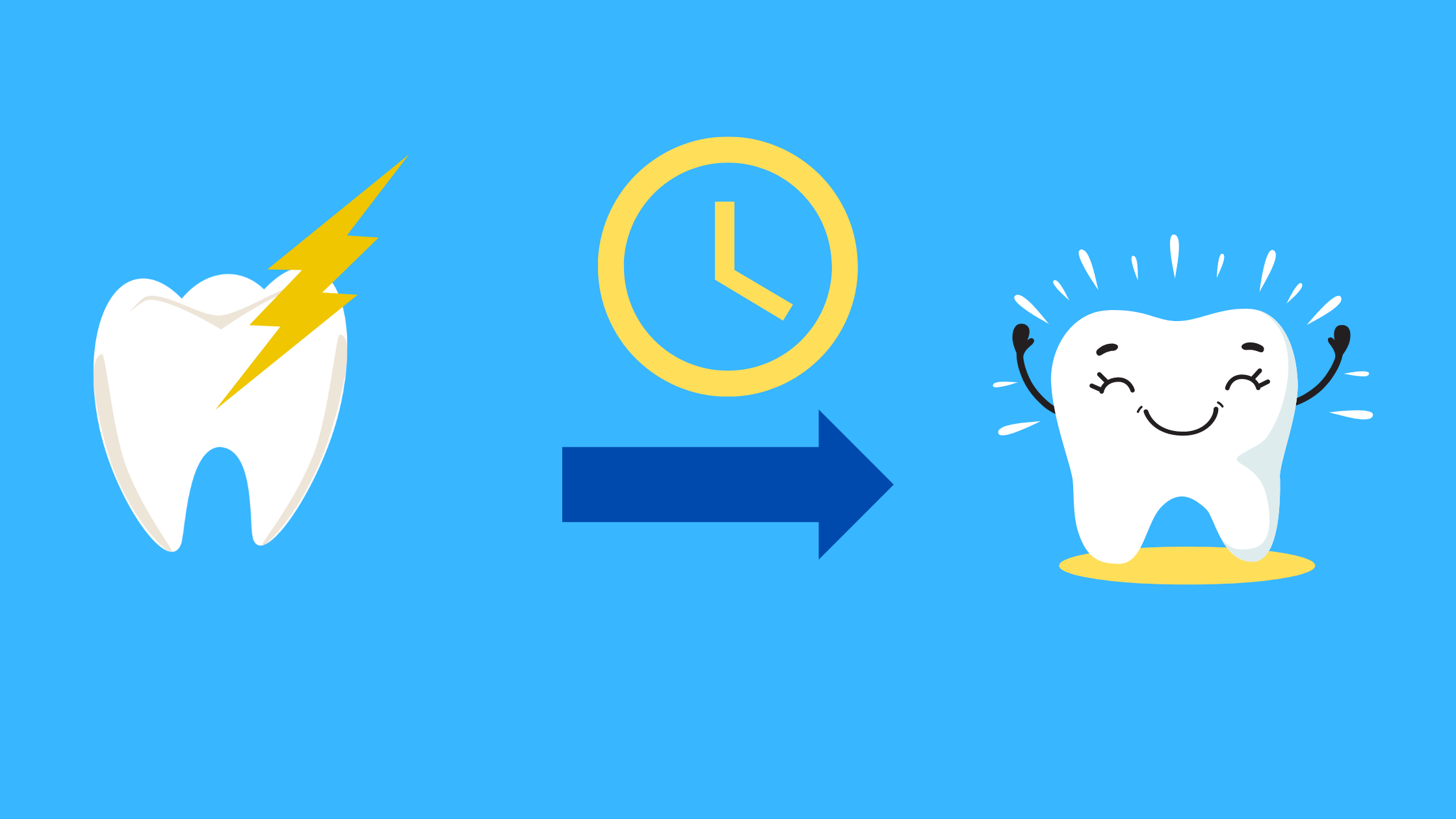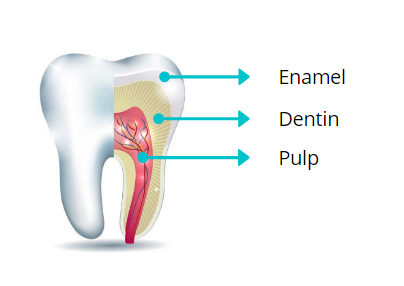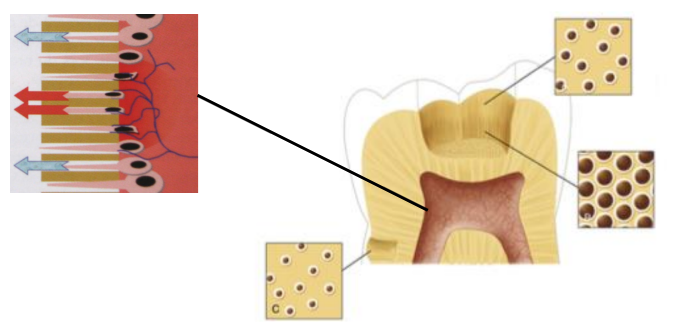Your 3-step guild to stop tooth sensitivity
 Do your teeth hurt when you eat something cold or sweet? If so, your teeth are probably sensitive.
Do your teeth hurt when you eat something cold or sweet? If so, your teeth are probably sensitive.
Tooth sensitivity, also called dentin hypersensitivity, is a common condition that causes short and sharp pain. It often affects several teeth and is triggered in specific situations: when you eat, brush your teeth, rinse or breathe through your mouth.
Before treating tooth sensitivity, you must first find the cause. In this article, learn the three steps to stop tooth sensitivity.
What is tooth sensitivity?

Our teeth are composed of two mineralized layers: the outermost is enamel, followed by the dentin. In the center of the tooth is a soft tissue called the pulp. It carries the blood vessels and nerves of the tooth.

Tooth sensitivity occurs when the dentin is exposed to the outside mouth environment.
Unlike enamel, dentin contains many fine canals called dentinal tubules. They go through the entire dentin thickness and connect with the tooth nerves.
Under healthy conditions, the dentin is covered by enamel at the top portion of the tooth and gums at the roots.
When these protective layers break down, they expose the dentinal tubules to the external environment. As a result, the nerve endings inside the tooth become vulnerable, causing sharp and short pain.
What can make your teeth sensitive?
Understanding the causes of tooth sensitivity is crucial, as the first line of treatment is to address the triggering factors.By identifying the factors that expose dentin, we can determine the nature of your toothache and how it affects your teeth (its intensity and how many teeth it affects). Here are some potential causes:
- Tooth wear: Over time, your tooth enamel can wear down due to factors like teeth grinding, acidic foods, or aggressive brushing. When the protective enamel thins out, it exposes the underlying dentin, which can lead to sensitivity.
- Receding gums: Gum recession occurs when the gum tissue around your teeth starts to pull back, exposing the roots. Receding gums can be a result of gum disease, brushing too hard, or aging. Since the roots are more vulnerable by nature, when they are exposed, teeth become more sensitive to stimuli.
- Other dental conditions: Tooth decay and fractures can also contribute to tooth sensitivity. When the tooth becomes injured, it can expose the sensitive inner layers of the tooth, leading to heightened discomfort.
How to stop tooth sensitivity or toothache?
Stopping tooth sensitivity means stopping its trigger. Therefore before starting a treatment, it is crucial to know the cause. Here are the three steps to get rid of tooth sensitivity:Step 1. Find and Address the Root Cause:
Finding the pain's origin is the first step in treating tooth sensitivity.First, you need to rule out some dental conditions, including:
- Cavities
- Fractures
- Gum or tooth infection
- Poorly fitting filling or restoration
If you suspect any of these conditions, see your dentist as soon as possible, as these require professional attention. If left untreated, they can progress further and worsen over time.
Once these dental conditions have been ruled out, you need to pinpoint the specific triggers and timing of your tooth sensitivity to address and manage it effectively. Here are a few tips to help you in this process:
- Correct your brushing technique: If brushing too hard is causing your tooth sensitivity, it's time to make a change. Switch to a toothbrush with soft bristles and adjust your brushing technique to gentle, circular motions.
- Adjust your diet: Certain foods and drinks, particularly those high in acidity, can erode tooth enamel and exacerbate sensitivity. Limit your consumption of acidic foods and beverages, and consider incorporating more enamel-strengthening foods into your diet, such as Leafy Green Vegetables and Dairy Products.
- Consider getting a mouthguard: If teeth grinding or clenching (bruxism) is a potential cause of your sensitivity, a custom-fitted mouthguard can help protect your teeth from further damage. Consult your dentist to discuss this option.
Step 2. Desensitizing Treatment:
The next step is to desensitize the affected tooth. This process involves applying specific products at home with soothing ingredients. The relief can be achieved in two different ways:- Numbing the nerve endings: Some desensitizing toothpastes contain Potassium Nitrate as an active ingredient. This compound helps to numb the nerve endings in the tooth, reducing the transmission of pain signals and providing temporary relief from sensitivity.
- Remineralizing and sealing the exposed dentinal tubules: Another approach to desensitization involves using products that contain active ingredients like Fluoride, Novamin, Strontium Chloride, or Arginine. These substances work by remineralizing the tooth structure and sealing the exposed dentinal tubules.
By strengthening the enamel and blocking the pathways that lead to sensitivity, these products provide long-term relief.
Step 3. Treatment at the dentist:
If the sensitivity persists after 3 to 4 weeks of applying the oral hygiene measures, it is time to see your dentist.In the dental office, your dentist may utilize more effective products that offer faster relief. Additionally, they may suggest restorative procedures or gum surgery, such as gum grafting, as a permanent solution to address the underlying cause. Here are the most common measures:
- Fluoride varnish or gel: The fluoride gel or varnish used in dental offices is highly concentrated. They help strengthen the enamel, thus offering better protection of the pulp against external stimuli. In addition, it has antibacterial and anti-cariogenic properties that help prevent cavities.
- Potassium nitrate: Applied as a highly concentrated gel, it helps to desensitize nerves.
- Isolating the tooth with a varnish or an adhesive: When the dentinal tubules are exposed in a specific area, your dentist may apply a product to close these fine canals and thus prevent sensitivity.
- Dental restoration: When your teeth are severely damaged, your dentist may restore the tooth with a filling or a dental crown. In addition to restoring the tooth shape, it will protect its underlying structures. This will isolate the pulp and avoid some painful complications.
- Gum Grafting: If your sensitivity is caused by gum recession, gum grafting is a good alternative to cover the roots and stop the sensitivity.
Your dentist will first evaluate if you are a suitable candidate for the procedure. If you are eligible, they will then choose the most appropriate technique for your situation.
Whatever the treatment, you must keep seeing your dentist regularly to maintain the results and prevent the sensitivity from coming back.
